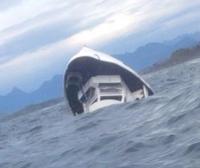
Photo: Albert Titian/Facebook
In 1998, the whale-watching boat Ocean Thunderer was hit by a wave and swamped, throwing all on board — three passengers and one boat operator — into the waters near Sea Lion Rocks, also known as Plover Reefs, off the western shore of Vancouver Island, Canada, near Tofino. The boat operator and one passenger drowned. The two other passengers were rescued, suffering from hypothermia.
Last Sunday, the whale-watching boat Leviathan II broached and capsized, throwing most of its passengers overboard near Sea Lion Rocks, not far from where Ocean Thunderer swamped seventeen years before. Five of the Leviathan II’s passengers drowned and one is still missing and presumed dead.
The death toll would have likely been much larger were it not for the rapid rescue by boats from the Ahousaht First Nation, as well as by other local fishermen. The water temperature on Sunday was around 55 degrees F. The investigation into the cause of the accident has just begun. Both whale-watching boats, Leviathan II & Ocean Thunderer, were owned by the same owner, Jamie’s Whaling Station & Adventure Centres.
The two whale-watching boats were extremely different, one to the other. Ocean Thunderer was an open 20′ long RIB, a Rigid Inflatable Boat. It had a twelve passenger capacity and was powered by two 135 horsepower outboard engines. The three passengers and one operator were all wearing full body “floater suits” which served as floatation and also provided some thermal protection in the cold waters off Vancouver Island, which were around 53 degrees when the accident took place in March of 1998. Despite the floater suits, two of the four drowned and the two survivors both suffered from hypothermia.
The Leviathan II was a 65′ long converted tug boat, built in 1981 and converted for whale watching in 1996. An upper deck was added during the conversion. Under Canadian safety regulations, an inclining test was not required following the conversion. Instead, a simple roll test was used in which the stability of the converted vessel could be estimated. When the Leviathan II capsized, it was reported that most of the passengers were on the upper deck on the port side. A wave from the starboard side struck the vessel before she broached and capsized. The passengers were not wearing PFDs or other protective gear. The Canadian Coast Guard has towed the capsized Leviathan II into protected waters and should be able to determine whether the vessel had the required stability for the number of passengers and the conditions.
The reports of the conditions on the water when the Leviathan II have been varied from being glassy smooth to choppy. Initial media reports of a “rogue wave” do not seem to be supported by the accounts of boaters in the area.
Why was it that both whale-watching boats would swamp or capsize at almost the same location almost two decades apart? It appears that after watching whales, the boats often go to Sea Lion Rocks, also known as Plover Reefs, to observe the seal rookeries. Tragically, the area around the rocks can be treacherous.
As reported by the Globe and Mail: Fishermen and fishing guides who were on the water on Sunday did not report seeing any huge waves, but they say the area’s intricate pattern of tides and winds can produce dangerous conditions in localized spots.
Steve Lawson, who lives year-round on Wickaninnish Island and travels on the waters of Clayoquot Sound almost daily, said that Plover Reef, where the accident occurred, can be such a location. It lies on the outer coast and is exposed to the big, steady waves, known as rollers, that come in from the open Pacific.
“It’s a tricky spot,” he said.

This is deja vu all over again:
An upper deck was added: like the charter fishing boat Joan La Rie III
Same modifications, same disastrous net results.
Rick,
Leviathan Ii was built as a high-speed crewboat, intended for carrying passengers. Original dimensions were 50’6′ x 15’3″ x 3’7″, service speed was 20 knots with triple Volvo outdrives. In 1996 she was lengthened to 65′, re-powered with twin surface drives and Volvo then Mitsubishi engines. Reportedly passenger certification was increased from the original 47 to 60, but I don’t have verification of that.
I do not know what the Transport Canada policy was in 1996, but since 2000 this conversion work, from “work boat” to “passenger vessel” would dictate she be treated as a “New Vessel”. There would be no grandfathering of anything, and new stability data would be developed after the conversion. I know CBC has reported something else but that’s not the case today, nor has it been for the past 15 years.
There is a large gap in the stability data requirements for vessels carrying more than 12 passengers. There are only 5 load cases required in the regulations, Light Ship, Light Operating, Departure (Full load), Arrival, and Worst Case. Worst case is one of the previous 4. There is no requirement to assess stability with a partial passenger load.
Very interesting. Thanks. The news reports said that boat was not inclined following the conversion, which was worrisome, although initial news reports are often wrong.